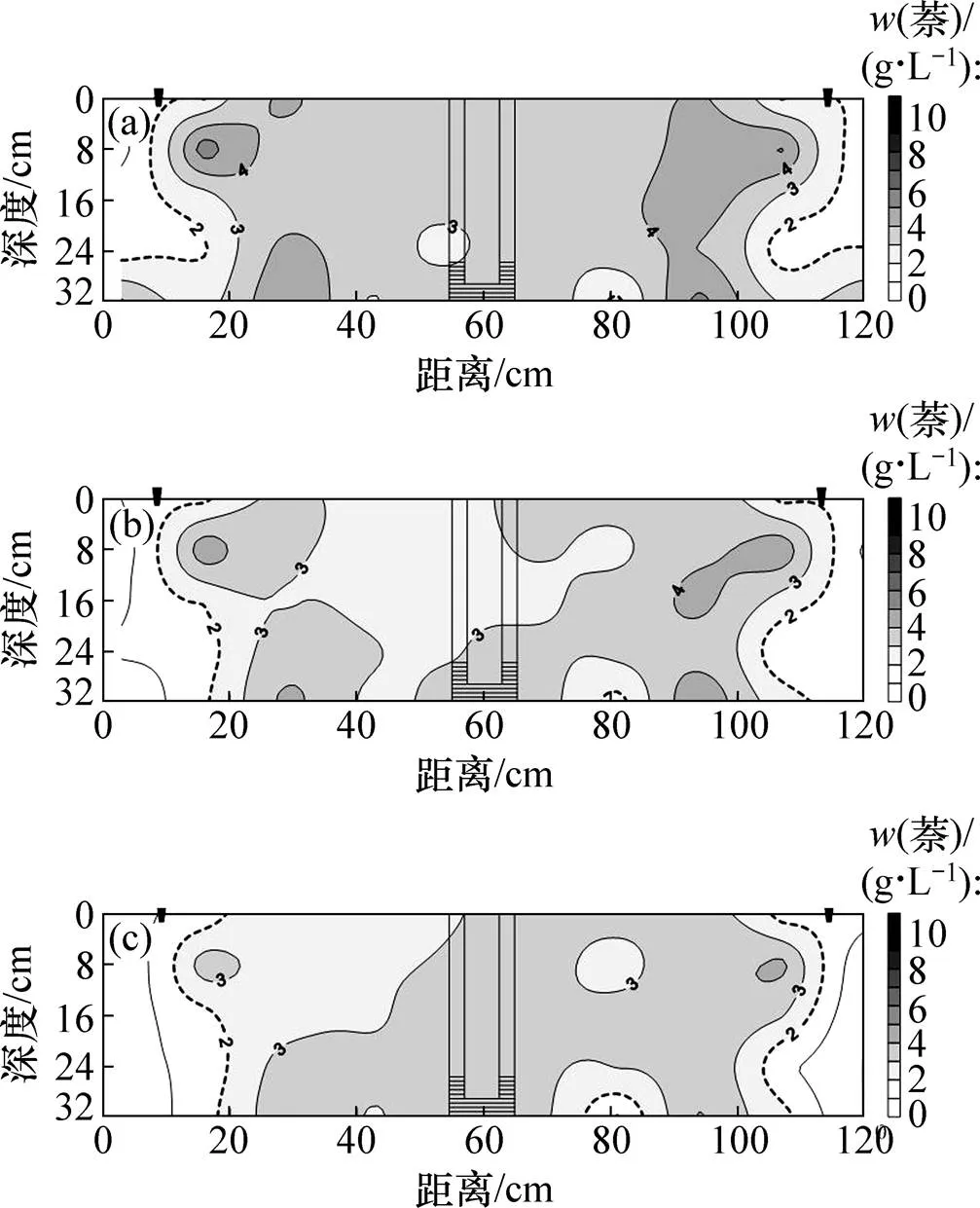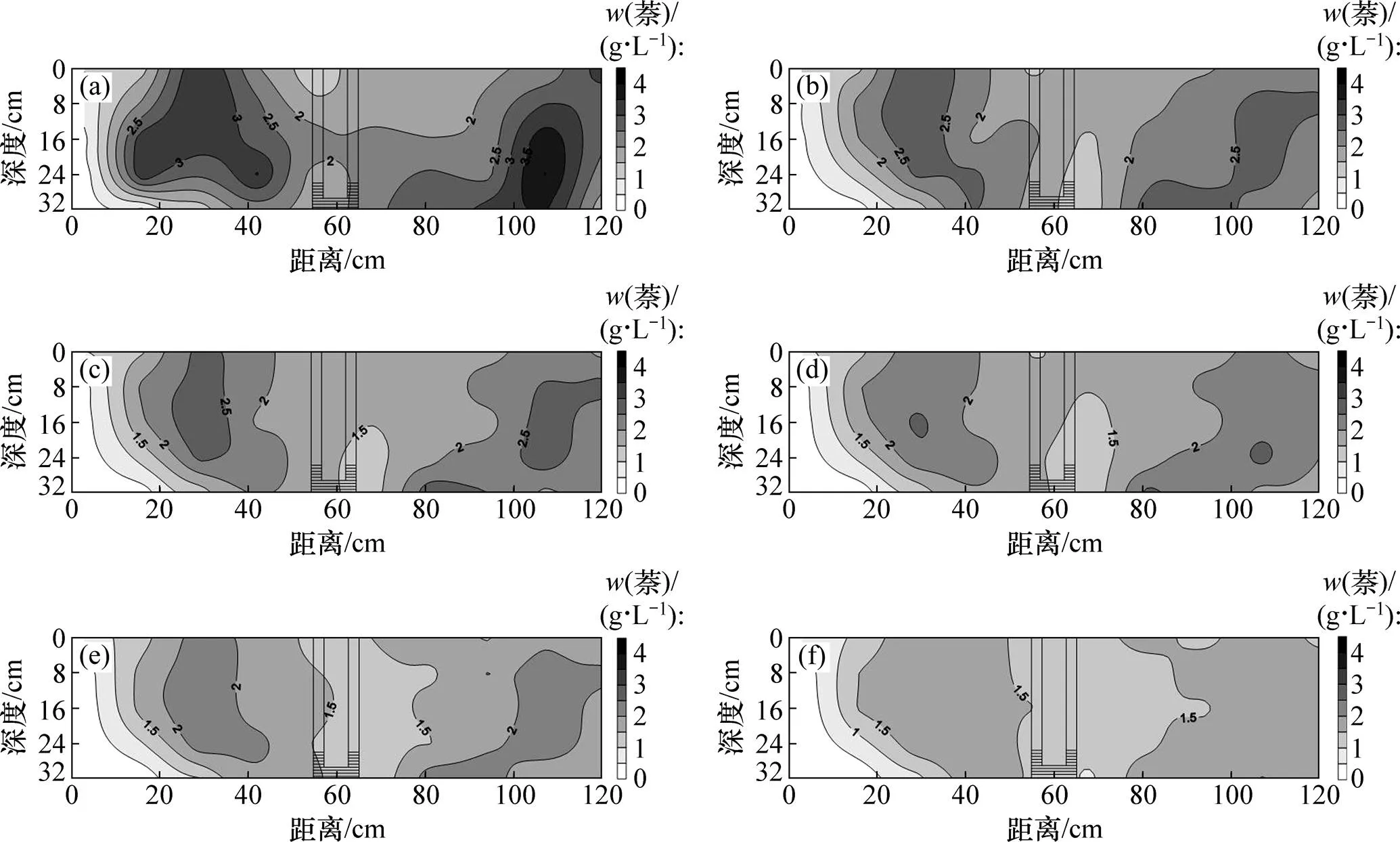基于增溶机理的Tween80强化地下水循井技术修复萘污染地下水
赵勇胜,焦维琦,孙超,秦传玉,白静
基于增溶机理的Tween80强化地下水循井技术修复萘污染地下水
赵勇胜,焦维琦,孙超,秦传玉,白静
(吉林大学环境与资源学院,地下水资源与环境教育部重点实验室,吉林长春,130021)
利用二维模拟槽实验研究Tween80增溶作用对地下水循环井技术(GCW)修复萘的强化效果。分析Tween80在地下水中的迁移特性、强化修复过程中地下水循环井对Tween80的水力控制作用、Tween80对萘的增溶效果及最终强化修复效果。研究结果表明:Tween80注入地下水后,其垂向迁移距离明显大于横向迁移距离;地下水循环井能够对Tween80进行有效的水力控制,将其控制在循环井周围;Tween80注入24 h后,模拟槽内萘的质量浓度普遍上升,平均质量浓度由1.82 mg/L上升至3.62 mg/L;启动循环井修复后,增溶至水中的萘在水流作用下不断迁移流向循环井,并通过曝气吹脱去除,最终在循环井附近形成一个高效修复区域。萘的质量浓度经历快速下降−缓慢下降的修复过程,高效修复时间集中在曝气的前2 h内,地下水中萘的平均质量浓度降至1.98 mg/L,之后进入缓慢下降阶段,萘的拖尾质量浓度为0.69 mg/L。
地下水;循环井;Tween80;增溶;萘
有机物在储藏、运输及使用过程中的泄露和不合理处置等已经造成严重的水土污染[1−2],因此,修复技术或技术组合的有效性成为环境领域的研究重点[3]。一些原位修复技术如地下水循环井技术(GCW)[4−7]、表面活性剂强化含水层修复技术(SEAR)[8−10]、原位空气扰动技术(AS)[11−13]、生物曝气修复技术(BS)[14]、可渗透反应屏障(PRB)[15−16]、土壤气相抽提(SVE)[17−18]、原位反应带技术(IRZ)[19−20]、监测自然衰减(MNA)和强化自然衰减(EMNA)[21−22]等,因其对环境扰动作用小,修复成本相对较低等特点,得到广泛应用。其中,GCW具有特殊的双井屏结构,能够在井周围形成地下水三维循环,形成强烈的垂直水力冲刷作用,使溶解在地下水中的有机物能在水流作用下,不断流向循环井,并通过曝气吹脱作用被去除。鉴于有机物普遍具有水相溶解度低,在环境介质中的吸附作用强和迁移性差的特点,GCW在修复后期,常存在有机物浓度拖尾现象[7]。SEAR的修复机理主要基于表面活性剂的增溶作用[23−26]、增流作用[27−28]及改善有机物生物可利用性[29−31]。目前,增溶作用主要集中在室内静态研究,主要是对增溶机理及动力学[32−33],增溶效果定量表达及影响因素等进行研究[34−36],对于利用二维槽模拟其在地下水中的迁移特性,对有机物的增溶效果等实际应用问题,尚未开展详细、系统的研究。针对上述情况,本文以萘为目标污染物, Tween80为强化表面活性剂,分析表面活性剂注入地下环境后的迁移规律;在启动GCW前,监测地下水中萘的质量浓度变化,分析Tween80在含水层中对萘的增溶效果;启动GCW后,分析Tween80的迁移性及质量浓度分布,研究GCW对Tween80的水力控制作用;监测不同累积曝气时间下地下水中萘质量浓度的变化,分析Tween80强化GCW修复萘的效果。实验以期通过上述室内二维模拟研究结果,为表面活性剂强化GCW的实际场地应用提供参考。
1 材料与方法
1.1 试验材料
试验用砂取自长春某采砂场,阴干后筛取粒径为0.25~0.50 mm的均质中砂作为实验介质,其渗透系数为0.3 mm/s,孔隙度为35.6%,有机质质量分数为0.33%,pH为7.15。萘为分析纯,水相溶解度为31 mg/L,亨利系数为36 Pa·m3/mol,蒸汽压为11.33 Pa(25 ℃)。
1.2 试验装置
试验装置为二维有机玻璃模拟槽,模拟槽长×宽×高为130 cm×30 cm×60 cm,模拟槽正面分布60个取样孔,共计6排10列,由上向下,由左及右分别为第1~6排和第1~10列。地下水循环井以滤布包裹,与槽底部接触,垂直安置在槽的中心位置(见图1)。由图1可见:槽中填装中砂,少量多次装入并不断夯实,填装高度为55 cm。在槽的第1列和第2列之间,砂面以下8 cm处,设置溶液注入槽,同时在槽对称的另一侧设置同样的溶液泄露槽。模拟槽左侧布水区缓慢进水,逐渐驱替介质中的空气,固定模拟槽右侧出水区高度为45 cm,调整进水区水位高度,使地下水流速为1~2 cm/d。

图1 模拟实验装置示意图
1.3 实验方法
萘在地下水中的迁移和GCW修复过程详见文献[7]。待GCW运行14 h后,以3.0 mL/min的速度分别在2个泄漏槽注入10.0 g/L的Tween80溶液,注入一定量后,取水样分析Tween80的质量浓度分布;静置24 h后,再次取水样测定萘的质量浓度。启动循环井,以0.7 m³/h曝气量进行内井曝气,并于不同累积曝气时间取水样,分析Tween80和萘的质量浓度变化。实验在相对密闭的室内进行,温度控制在(25±1) ℃。
2 结果与讨论
2.1 Tween80对萘的增溶作用
GCW单独运行14 h后,地下水中残留萘的最高质量浓度和平均质量浓度分别为3.13 mg/L和1.82 mg/L,并且大多分布在远离循环井的区域[7]。图2所示为Tween80注入后萘的质量浓度分布图。由图2可见:Tween80注入后萘的质量浓度明显上升,最高质量浓度和平均质量浓度分别上升至5.73 mg/L和3.62 mg/L,质量浓度上升区域与Tween80注入区域基本吻合。
图2表明注入的Tween80起到增溶作用,提高了地下水中萘的质量浓度,但增溶效果低于静态增溶实验所得的萘的质量浓度489.70 mg/L[36],分析原因可能是:地下环境是由土壤介质、水、污染物和表面活性剂组成的复杂体系,增溶作用受表面活性剂浓度、污染物自身浓度、污染物的吸附/解吸作用及两者有效接触面积综合作用影响,较单纯的增溶实验,二维模拟槽中萘的增溶效果受到一定程度的限制。因此,在实际应用过程中,在考察表面活性剂的增溶效果时,须综合考虑环境介质、表面活性剂和污染物吸附/解吸性能等多重因素的影响。

图2 Tween80注入后萘的质量浓度分布
2.2 GCW对Tween80的水力控制
表面活性剂注入地下水后,要明确其在地下水中的迁移规律和质量浓度分布,并进行有效合理的水力控制,使其集中作用于污染区域。GCW单独运行14 h后,地下水中残留的萘集中分布于模拟槽的两侧[7],为强化这2个区域内萘的修复效果,在图1所示的2个泄漏槽位置,分别注入一定体积的Tween80溶液,其在地下水中的质量浓度分布如图3所示。

图3 曝气前Tween80质量浓度分布
由图3可知:Tween80基本上对称分布于循环井的两侧。质量浓度超过2.0 g/L的区域面积超过整个模拟槽剖面面积的70%(图3虚线),且其在地下水中横向迁移距离小于垂向迁移距离。以5.0 g/L质量浓度迁移锋面(注入质量浓度的50%)为例,Tween80的横向迁移距离不足15 cm,明显小于垂向迁移距离(此时,Tween80的垂向迁移距离已经超过32 cm)。因此,Tween80在实际应用过程中,应密切关注其羽状体的变化范围,使其尽量集中于污染区域,避免表面活性剂的浪费及地下水二次污染。
图4所示为累积曝气时间分别为1,7和14 h时Tween80的质量浓度分布。由图4可知:经曝气后,Tween80的质量浓度峰值均有不同程度下降,这可能是在GCW运行后,Tween80与含水层介质的接触面积增大,稀释及吸附作用所致;Tween80的分布相对集中,并呈现逐渐向循环井靠近的趋势,这说明随着曝气的延续,远离GCW的Tween80逐渐被水流带向循环井附近;Tween80有效作用区域(质量浓度大于2.0 g/L的区域)较曝气前明显增大,均超过槽剖面面积的90%。 GCW运行对Tween80质量浓度分布的影响表明:GCW能够对表面活性剂的迁移进行良好的水力控制,使其相对集中于GCW的影响区域内。

累积曝气时间/h:(a) 1;(b) 7;(c) 14
2.3 Tween80强化修复效果
图5所示为不同累积曝气时间下萘的质量浓度变化图。由图5可知:随着曝气时间延长,地下水中的萘的质量浓度逐渐降低,与循环井距离越近,萘的修复效果越明显,这与循环井单独运行时,首先在井周围形成的一个高效修复区域的现象类似。

累积曝气时间/h:(a) 1;(b) 2;(c) 4;(d) 7;(e) 11;(f) 14
以曝气前所有取样口水样中萘平均质量浓度记为0,不同累计曝气时间下萘的质量浓度为,萘的质量浓度比/0的变化趋势如图6所示。

图6 不同累积曝气时间萘的质量浓度比变化
由图6可知:萘的质量浓度经历了快速下降−缓慢下降的修复过程。当累积曝气时间为1 h时,/0快速下降至0.60;当累积曝气时间为2 h时,萘的质量分数继续呈现降低趋势,/0达到0.54,对应萘的质量浓度为1.98 mg/L;之后萘的修复进入浓度缓慢下降阶段,在累积曝气时间为14 h时,残留在地下水中萘的质量浓度比/0为0.38,平均残留质量浓度降至0.69 mg/L。
分析整个强化修复过程可知:当Tween80注入到地下水中后,能够形成有效的增溶区域,提高萘在水相的质量浓度;启动地下水循环井后,Tween80基本上集中分布于循环井的周围,并且逐渐向循环井靠近;增溶在Tween80胶束中的萘,能够在地下水水流的作用下,不断流向循环井,并由曝气吹脱被最终去除。
3 结论
1) 当Tween80注入到地下水后,能形成有效增溶区域,提高萘的水相质量浓度,萘的平均质量浓度由增溶前的1.82 mg/L上升至3.62 mg/L。
2) Tween80在地下水中的垂向迁移距离大于横向;地下水循环井能够对Tween80的迁移起到良好的水力控制作用,使其相对集中在循环井的影响区域内。
3) 增溶后的萘能够通过曝气吹脱去除,并且在地下水水流的作用下不断流向循环井,最终在循环井周围形成一个高效修复区域;萘的质量浓度经历了快速下降−缓慢下降的修复过程,当累积曝气时间为2 h时,地下水中萘的平均质量浓度下降至1.98 mg/L,在累积曝气时间为14 h后,残留萘的平均质量浓度为0.69 mg/L。
[1] 陆海燕, 辛宝东, 孙颖, 等. 北京市平原区地下水有机污染时空分布特征[J]. 水文地质工程地质, 2014, 41(1): 34−40. LU Haiyan, XIN Baodong, SUN Ying, et al. Temporal and spatial distribution characteristics of organic contamination in groundwater in the Beijing plain[J]. Hydrogeology and Engineering Geology, 2014, 41(1): 34−40.
[2] 杨明星, 杨悦锁, 杜新强, 等. 石油污染地下水有机污染组分特征及其环境指示效应[J]. 中国环境科学, 2013, 33(6): 1025−1032. YANG Mingxing, YANG Yuesuo, DU Xinqiang, et al. Organic fractions and their environmental implications of petroleum contaminated groundwater[J]. China Environmental Science, 2013, 33(6): 1025−1032.
[3] Naidu R. Recent advances in contaminated site remediation[J]. Water, Air & Soil Pollution, 2013, 224(12): 1705−1716.
[4] Johnson R L, Simon M A. Evaluation of groundwater flow patterns around a dual-screened groundwater circulation well[J]. Journal of Contaminant Hydrology, 2007, 93(5): 188−202.
[5] Goltz M N, Close M E, Yoon H, et al. Validation of two innovative methods to measure contaminant mass flux in groundwater[J]. Journal of Contaminant Hydrology, 2009, 106(5): 51−61.
[6] Goltz M N, Gandhi R K, Gorelick S M, et al. Field evaluation of in situ source reduction of trichloroethylene in groundwater using bioenhanced in-well vapor stripping[J]. Environmental Science & Technology, 2005, 39(6): 8963−8970.
[7] 白静, 孙超, 赵勇胜. 地下水循环井技术对典型NAPL污染物修复模拟[J]. 环境科学研究, 2014, 27(1): 84−91. BAI Jing, SUN Chao, ZHAO Yongsheng. Remediation simulation of groundwater circulation well of NAPL contaminated aquifer[J]. Research of Environmental Sciences, 2014, 27(1): 84−91.
[8] Ghosh J, Ticksurf G R. A pore scale investigation of crude oil distribution and removal from homogeneous porous media during surfactant-induced remediation[J]. Journal of Contaminant Hydrology, 2013, 155(12): 20−30.
[9] Jayanti S, Britton L N, Dwarakanath V, et al. Laboratory evaluation of custom-designed surfactants to remediate NAPL source zones[J]. Environmental Science & Technology, 2002, 36(24): 5491−5497.
[10] Espriú A H, León E S, Santos P M, et al. Remediation of a diesel-contaminated soil from a pipeline accidental spill: Enhanced biodegradation and soil washing processes using natural gums and surfactants[J]. Journal of Soils and Sediments, 2013, 13(10): 152−165.
[11] HU Liming, WU Xiaofeng, LIU Yan, et al. Physical modeling of air flow during air sparging remediation[J]. Environmental Science & Technology, 2010, 44 (10): 3883−3888.
[12] YANG Xiaomin, Beckmann D, Fiorenza S, et al. Field study of pulsed air sparging for remediation of petroleum hydrocarbon contaminated soil and groundwater[J]. Environmental Science & Technology, 2005, 39(18): 7279−7286.
[13] 秦传玉, 赵勇胜, 郑苇, 等. 空气扰动技术对地下水中氯苯污染晕的控制及去除效果[J]. 吉林大学学报(地球科学版), 2010, 40(1): 164−168. QIN Chuanyu, ZHAO Yongsheng, ZHENG Wei, et al. Pollution plume control and removal efficiency of chlorobenzene in groundwater by air sparging[J]. Journal of Jilin University (Earth Science Edition), 2010, 40(1): 164−168.
[14] Davis G B, Patterson B M, Johnston C D. Aerobic bioremediation of 1, 2 dichloroethane and vinyl chloride at field scale[J]. Journal of Contaminant Hydrology, 2009, 107(5): 91−100.
[15] Mieles J, ZHAN Hongbin. Analytical solutions of one-dimensional multispecies reactive transport in a permeable reactive barrier-aquifer system[J]. Journal of Contaminant Hydrology, 2012, 134/135(2): 54−68.
[16] 刘翔, 唐翠梅, 陆兆华, 等. 零价铁PRB技术在地下水原位修复中的研究进展[J]. 环境科学研究, 2013, 26(12): 1309−1315. LIU Xiang, TANG Cuimei, LU Zhaohua, et al. Progress of Fe0-PRB in remediation of contaminated groundwater[J]. Research of Environmental Sciences, 2013, 26(12): 1309−1315.
[17] QIN Chuanyu, ZHAO Yongsheng, ZHENG Wei, et al. Study on influencing factors on removal of chlorobenzene from unsaturated zone by soil vapor extraction[J]. Journal of Hazardous Materials, 2010, 176(1/2/3): 294−299.
[18] Rahbeh M E, Mohtar R H. Application of multiphase transport models to field remediation by air sparging and soil vapor extraction[J]. Journal of Hazardous Materials, 2010, 176(1/2/3): 294−299.
[19] Liang S H, Kao C M, Kuo Y C, et al. In situ oxidation of petroleum-hydrocarbon contaminated groundwater using ISCO system[J]. Water Research, 2011, 45(8): 2496−2506.
[20] 孙威. 地下水中苯类有机污染的原位反应带修复技术研究[D]. 长春: 吉林大学环境与资源学院, 2012: 23−94. SUN Wei. Study on the remediation of benzene-based groundwater pollution by in situ reactive zone[D]. Changchun: Jilin University. School of Environmental and Resource, 2012: 23−94.
[21] 屈智慧, 赵勇胜, 王冰, 等. 柴油污染包气带环境的自然衰减作用[J]. 哈尔滨工业大学学报, 2011, 43(4): 136−141. QU Zhihui, ZHAO Yongsheng, WANG Bing, et al. Research on the natural attenuation of vadose zone polluted by diesel[J]. Journal of Harbin Institute of Technology, 2011, 43(4): 136−141.
[22] Scow K M, Hichs K A. Natural attenuation and enhenced bioremediation of organic contaminants in groundwater[J]. Current Opinion in Biotechnology, 2005, 16(3): 246−253.
[23] ZHENG Guanyu, Selvam A, Wong J W C.Enhanced solubilization and desorption of organochlorine pesticides (OCPs) from soil by oil-swollen micelles formed with a nonionic surfactant[J]. Environmental Science & Technology, 2012, 46(21): 12062−12068.
[24] Paria S, Yuet P K. Solubilization of naphthalene by pure and mixed surfactants[J]. Industrial and Engineering Chemistry Research, 2006,45(1): 3552−3558.
[25] Bernardez L A, Ghoshal S. Selective solubilization of polycyclic aromatic hydrocarbons from multicomponent nonaqueous-phase liquids into nonionic surfactant micelles[J]. Environmental Science & Technology, 2004, 38(20): 5878−5887.
[26] 陈宝梁. 表面活性剂在土壤有机污染修复中的作用及机理[D]. 杭州: 浙江大学环境与资源学院, 2004: 64−77. CHEN Baoliang. The role of surfactant in soil organic pollutant remediation and its mechanism[D]. Hangzhou: Zhejiang University. School of Environmental & Resource, 2004: 64−77.
[27] Duffield A R, Ramamurthy R S, Campanelli J R. Surfactant enhanced mobilization of mineral oil within porous media[J]. Water Air and Soil Pollution, 2003, 143(1/2/3/4): 111−122.
[28] CHEN Jing, WANG Xuejun, HU Jundong, et al. Modeling surfactant LAS influenced PAHs migration in soil column[J]. Water Air and Soil Pollution, 2006, 176(1/2/3/4): 217−232.
[29] Montes M B, Springael D, Calvo J O. Effect of a nonionic surfactant on biodegradation of slowly desorbing PAHs in contaminated soils[J]. Environmental Science & Technology, 2011, 45(5): 3019−3026.
[30] Amos B K, Daprato R C, Hughes J B, et al. Effects of the nonionic surfactant Tween80 on microbial reductive dechlorination of chlorinated ethene[J]. Environmental Science & Technology, 2007, 41(5): 1710−1716.
[31] ZHU Hongbo, Singleton D R, Aitken M D. Effects of nonionic surfactant addition on populations of polycyclic aromatic hydrocarbon-degrading bacteria in a bioreactor treating contaminated soil[J]. Environmental Science & Technology, 2010, 44(19): 7266−7271.
[32] Hill A J, Ghoshal S. Micellar solubilization of naphthalene and phenanthrene from nonaqueous-phase liquids[J]. Environmental Science & Technology, 2002, 36(18): 3901−3907.
[33] Prak D J L, Abriola L M, Weber W J, et al. Solubilization rates of n-alkanes in micellar solutions of nonionic surfactants[J]. Environmental Science & Technology, 2000, 34(22): 476−482.
[34] Lee D H, Chang H W, Chul K. Mixing effect of NaCl and surfactant on the remediation of TCB contaminated soil[J]. Geosciences Journal, 2008, 12(1): 63−68.
[35] Saenton S, Illangasekare T H, Soga K, et al. Effects of source zone heterogeneity on surfactant-enhanced NAPL dissolution and resulting remediation end-points[J]. Journal of Contaminant Hydrology, 2002, 59(3/4): 27−44.
[36] 白静, 赵勇胜, 周冰, 等. 非离子表面活性剂Tween80增溶萘实验模拟[J]. 中国环境科学, 2013, 33(11): 1993−1998. BAI Jing, ZHAO Yongsheng, ZHOU Bing, et al. Laboratory investigation of solubilization of naphthalene by nonionic surfactant Tween80[J]. China Environmental Science, 2013, 33(11): 1993−1998.
Solubilization of Tween80 on enhanced remediation of naphthalene contaminated groundwater by ground water circulation well
ZHAO Yongsheng, JIAO Weiqi, SUN Chao, QIN Chuanyu, BAI Jing
(Key Laboratory of Groundwater Resources and Environment (Ministry of Education),School of Environment and Resources, Jilin University, Changchun 130021, China)
A two-dimensional simulated sand box was used to investigate the remediation efficiency of naphthalene contaminated groundwater by Tween80-enhanced groundwater circulation well (GCW). The mobility characteristic of Tween80 in groundwater, the hydraulic control of Tween80 by GCW during the remediation process, the solubilization of naphthalene as well as the enhanced remediation effect were all studied. The results show that the vertical mobility rate of Tween80 is higher than that in longitudinal direction after adding Tween80 to ground water. The mobility of Tween80 can be controlled by GCW perfectly. And Tween80 flows to GCW gradually in the process of GCW. Solubilization of naphthalene by Tween80 is obvious 24 h after Tween80 is added. The average mass concentration of naphthalene in simulate slot increases from 1.82 mg/L to 3.62 mg/L. The solubilized naphthalene is carried to GCW by groundwater after starting the remediation of circulation well. A cone-shaped remediation area is gradually formed around GCW and naphthalene can be removed by aeration. The mass concentration of naphthalene goes through the two stages of rapid decline and slow decline. In the first 2 h of efficient remediation time in the aeration, the average mass concentration of naphthalene decreases fast to 1.98 mg/L followed by a slow decline, and the trailing concentration is 0.69 mg/L.
groundwater; circulation well; Tween80; solubilization; naphthalene
10.11817/j.issn.1672-7207.2015.10.054
X523
A
1672−7207(2015)10−3969−06
2015−01−10;
2015−03−19
国家自然科学基金资助项目(41272256); 北京市教育委员会市属高校创新能力提升计划项目(TJSHG201310772028) (Project (41272256) supported by the National Science Foundation of China; Project (TJSHG201310772028) supported by University Innovation Ability of Beijing Municipal Education Commission)
白静,博士,从事污染场地的控制与修复研究;E-mail:baijing927@jlu.edu.cn
(编辑 刘锦伟)

